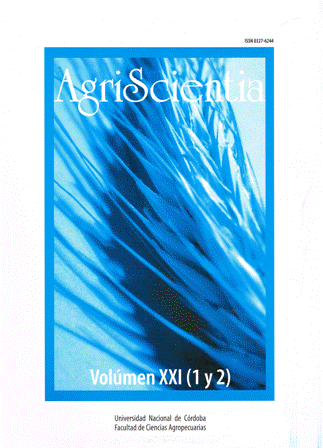Ver ítem
- xmlui.general.dspace_homeCentros Regionales y EEAsCentro Regional Buenos Aires NorteEEA San PedroArtículos científicosxmlui.ArtifactBrowser.ItemViewer.trail
- Inicio
- Centros Regionales y EEAs
- Centro Regional Buenos Aires Norte
- EEA San Pedro
- Artículos científicos
- Ver ítem
Aptitud de modelos de temperaturas y de tiempo térmico en brócoli (Brassica oleracea var. italica)
Resumen
Para comparar la capacidad de predecir ciclo, rendimiento comercial y diámetro de la pella de modelos de tiempo térmico con modelos basados en temperaturas;se analizaron los rangos térmicos registrados en 11 siembras del híbrido Legacy. Se establecieron 49 combinaciones de temperaturas máximas y mínimas y siete temperaturas mínimas sin umbral superior, para calcular días grado a través del programa Degree Day Utility (DDU) 2.3. Se realizó la regresión de
[ver mas...]
Para comparar la capacidad de predecir ciclo, rendimiento comercial y diámetro de la pella de modelos de tiempo térmico con modelos basados en temperaturas;se analizaron los rangos térmicos registrados en 11 siembras del híbrido Legacy. Se establecieron 49 combinaciones de temperaturas máximas y mínimas y siete temperaturas mínimas sin umbral superior, para calcular días grado a través del programa Degree Day Utility (DDU) 2.3. Se realizó la regresión de ciclo, rendimiento y diámetro con los días grado y con las temperaturas. Los modelos de tiempo térmico con mayor coeficiente de determinación para rendimiento (R2=0,56) y diámetro (R2=0,53) utilizaron los días grado acumulados desde transplante a diferenciación floral, y los umbrales 10-21 °C y 10-24 °C, respectivamente.Para ciclo, el mejor modelo de tiempo térmico (R2=0,51) incluyó los días grado acumulados entre diferenciación floral y madurez y los umbrales 7-23 °C.Los modelos que utilizaron las temperaturas sin transformar estimaron con mayor precisión los parámetros evaluados que los modelos de tiempo térmico. Los que incluyeron temperaturas medias tuvieron los mayores R2: para rendimiento (R2=0,60) y diámetro (R2= 0,72) participaron los valores medios registrados entre transplante y madurez y para ciclo (R2=0,90) los observados entre diferenciación floral y madurez.
[Cerrar]
In order to compare the ability of thermal time models based on degree day vs. temperature models to predict cycle, commercial yield and spear diameter; we studied temperature ranges in 11 sowings of the hybrid Legacy. We set up seven minimum temperatures without upper thresholds and 49 minimum and maximum temperature combinations to calculate degree day through the software Degree Day Utility (DDU) 2.3. Cycle, yield and diameter were regressed on degree
[ver mas...]
In order to compare the ability of thermal time models based on degree day vs. temperature models to predict cycle, commercial yield and spear diameter; we studied temperature ranges in 11 sowings of the hybrid Legacy. We set up seven minimum temperatures without upper thresholds and 49 minimum and maximum temperature combinations to calculate degree day through the software Degree Day Utility (DDU) 2.3. Cycle, yield and diameter were regressed on degree day and on temperatures. The thermal time models with the highest R2 included degree day in the period transplant-flower differentiation, and the thresholds 10-21° C for yield (R2=0.56) and 10-24° C for diameter (R2=0.53). The best thermal time model to explain the variability in cycle (R2=0.51) included degree day in the period flower differentiation-maturity and the thresholds 7-23° C. The parameters were more precisely estimated by temperature models than by thermal time models. Those including medium temperatures had the largest R2. Yield (R2=0.60) and diameter (R2= 0.72) models included medium temperatures in the period transplant-maturity; and cycle (R2=0.90) models included medium temperatures in the period flower differentiation-maturity.
[Cerrar]

Autor
Francescangeli, Nora;
Stoppani, María Inés;
Martí, Hector Ruben;
Fuente
AgriScientia 21 (2) : 51-57. (2004)
Fecha
2004
Editorial
Facultad de Ciencias Agropecuarias, Universidad Nacional de Córdoba
ISSN
0327-6244
Formato
pdf
Tipo de documento
artículo
Palabras Claves
Derechos de acceso
Abierto
 Excepto donde se diga explicitamente, este item se publica bajo la siguiente descripción: Creative Commons Attribution-NonCommercial-ShareAlike 2.5 Unported (CC BY-NC-SA 2.5)
Excepto donde se diga explicitamente, este item se publica bajo la siguiente descripción: Creative Commons Attribution-NonCommercial-ShareAlike 2.5 Unported (CC BY-NC-SA 2.5)


